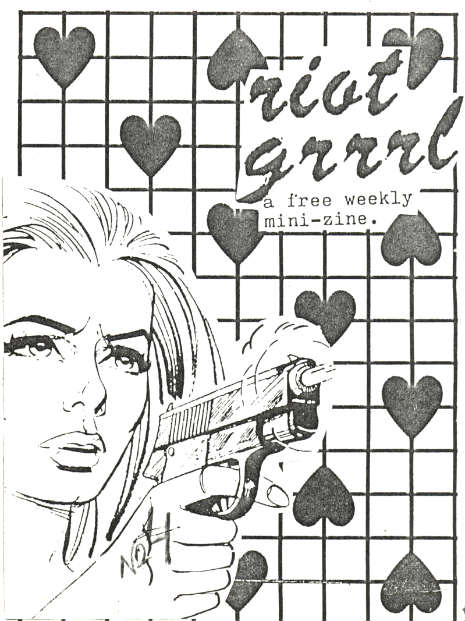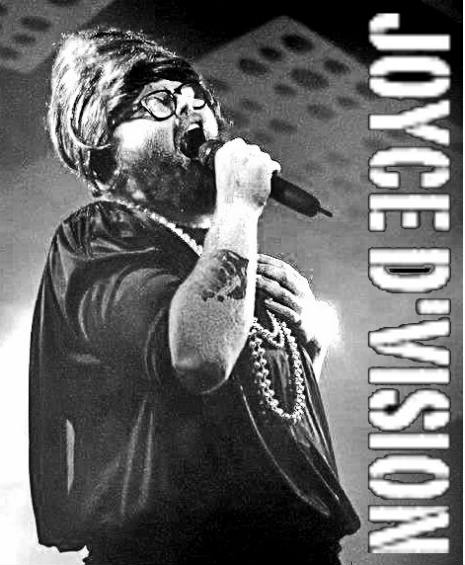
Quite possibly the finest use of the Youtube I’ve come across yet. You’re welcome.
Thanks to the redoubtable Jimi Hey !

Quite possibly the finest use of the Youtube I’ve come across yet. You’re welcome.
Thanks to the redoubtable Jimi Hey !

As an introduction to a brief but important music movement, or even just a simple nostalgia piece for people who were around at the time, Kerri Koch’s 2006 documentary Don’t Need You: The Herstory of Riot Grrrl makes for interesting and compelling viewing.
For a brief while in the early 90s it seemed Riot Grrrl was everywhere. It was a breath of fresh air in the male-dominated grunge landscape, though some of those grunge bands did their best to promote it and more pro-feminist ideals (the ghost of Kurt looms into view in a flowing, floral-print dress). But Riot Grrrl was met mostly with derision in the mainstream media, what with its core values of fanzines and localised press, not to mention of course feminism, self-expression and the forcing through of female self-determination in a male-oriented world.
Looking back now It’s hard to believe how much of an uproar some female musicians simply being angry could cause, but then as has been mentioned numerous times no-one wants to see women being angry (supposedly). Pretty soon Riot Grrrl was reduced to a simple concept of being merely “angry girls”, and made easy to dismiss. UK Riot Grrrl contingent Huggy Bear famously got ejected from the studios of tacky yoof program The Word (on which they had just performed) for heckling the presenters about their Barbie doll-imitating porn star guests. This got the band into the national media, but also sealed their fate as mere rabble-rousers while ignoring their efforts to create alternative spaces and dialogs. But still, Riot Grrrl was oppositional, it was dramatic, and it was fucking exciting.
Just as quickly as it bubbled up however, Riot Grrrl seemed to fizzle out. I guess my perception of this was skewed hugely by the mainstream UK music press, which was my only port of access to alternative music and culture in those pre-internet days. It was a mutual love/hate thing (more hate/hate I guess) with the performers and the scene itself withdrawing from the mainstream attention and the negative associations it brought. In a very interesting read called Riot Grrrl - the collected interviews on Collpase Board, Everett True (the editor of Melody Maker at the time, and the person chiefly responsible for breaking the scene in the UK music media) explains his own role and that of the press:
Riot Grrrl was basically about female empowerment – females doing stuff on their own terms, separate from men, making up their own rules and systems and cultures. Sure, men were welcome, but they had to understand that for once they weren’t going to be automatically given first place. (One of the reasons my own role in the gestation of Riot Grrrl as a popular cultural movement became so confused was that after a certain period of time I began to listen to those around me – female musicians, activists, artists, human beings – who felt that having such a high-profile male associated with a fledgling female movement was absolutely counter-productive. This is almost the first time I’ve spoken to anyone since then.)
Don’t Need You - The Herstory of Riot Grrrl is important because it lets the creators of the movement speak for themselves. The editing may be rough in places, and the story may jump around in chronology a wee bit, but you get to hear first hand from the original Riot Grrrls themselves what informed their third-wave feminist views and what inspired them to start their own scene. Featured interviewees include Kathleen Hanna of Bikini Kill, Alison Wolfe of Bratmobile, Corin Tucker of Heavens To Betsy / Sleatter-Kinney and Fugazi’s Ian McKaye:
That’s part one - part two and part three are after the jump…

Captain Beefheart t-shirt by Black And White T-shirts
This excellent documentary from 1997, narrated by John Peel and shown as part of a commemorative BBC Peel Night, has been online for a while but finally arrives in one 50 minute long piece thanks to uploader abrahamisagreatman. You may have seen this before, but it’s definitely worth another watch:

So, dear readers, this is one of the things I do when I am not busy scribbling and posting here on DM - I am part of a Joy Division tribute act called Joyce D’Vision. As the name would suggest, it’s not just any run-of-the-mill tribute act - it’s a drag queen tribute, fusing those two quintessentially Northern English traits of woe-is-me miserableism and end-of-the-pier transvestitism.
Before you ask, no, I am not Joyce D’Vision herself, but rather Noel Order, keyboard whizz extraordinaire and Bontempi aficionado. Joyce is played by the very talented Joe Spencer, and we are often joined on stage by other queens such as Sheela Blige, Kurt Dirt and Sahara Dolce. Joyce has been lucky enough to share the stage with British queer performance legends like David Hoyle (The Divine David) and Scottee Scottee (Eat Your Heart Out), but those were just warm-ups for what happened last week…
A few months ago Joe took part in a reality competition show May The Best House Win, where Joyce and friends had a cameo near the end. The program was finally broadcast last Tuesday, and seen by the comedian Harry Hill, himself a fan of Joy Division. Harry hosts a show called TV Burp, which looks over the best bits of the last week’s telly, and he invited Joyce and her friends to London to sing live on the show. Joyce performed as the final segment on the final show of the series, which was broadcast right before X Factor. Meaning that this went out on a Saturday evening, just after dinner time when everyone’s getting ready to watch the biggest show of the week. Seriously - that’s prime fucking time.
The reaction since (mostly gauged through Twitter) has been interesting - some people really get it, while others have stated that Ian Curtis would be rolling in his grave. I like to think Curtis would have seen the funny side, as would Tony Wilson I’m sure, and we have heard through the grapevine that there are even Joyce fans in the New Order camp.
Joyce D’Vision is not done out of hatred of the band or the man, but rather from love - and a simple desire to deflate the pomposity that surrounds JD and their legend, as perpetuated by magazines like NME and high street stores like Primark (currently selling an Ian Curtis t-shirt). So while the idea (and sight) of a fat, bearded man in a wig singing a boss nova version of “Love Will Tear Us Apart” is definitely going to rub some people up the wrong way, I’m pretty sure our readers here at DM can handle it:
For more info on Joyce, visit her Facebook page.

Modified Casio keyboard by Tablebeast
Noise may not be to everyone’s taste (in fact by definition noise is classed as “unwanted” sounds) but to the hardcore few it’s a way of life. This documentary follows some of those artists and shows them performing live, often on homemade or radically modified kit, and talking about the philosophy and influences behind their work. You won’t have heard of many of these performers but that’s the point - they are not in it for fame or money, they are simply following their muse in as unhindered a way as possible.
Most of the artists featured in People Who Do Noise are based in Portland, Oregon, and here’s a bit more info via the site filmbaby:
The film takes a very personal approach, capturing the musicians working alone with no interference from a live audience. What often took place in crowded basements or dark smoky venues was stripped bare for the cameras, providing an unprecedented glimpse of the many different instruments and methods used.
Covering a wide range of artists and styles, the film features everything from the absurdist free-improvisations of genre-pioneers Smegma, to the harsh-noise assaults of Oscillating Innards and everything in between. Many of the artists in the film, such as Yellow Swans and Daniel Menche, have performed and sold records all over the world. In spite of such successes, noise music remains one of the least understood and most inaccessible of genres.
OK, so most of this is pushing at the very boundaries of what we call “music”, but that’s pretty much the point. Casual observers (and listeners) may not make it very far into this doc because of, well, the noise, but it’s worth resisting the urge to skip forward as you may miss some very interesting interview footage. While some of these performers come across as pretentious, regardless of what you think of the sounds they create you can’t help but admire their freedom and lack of constraints:

Is this the end for Sonic Youth? It’s not clear yet whether the divorce of Kim Gordon and Thurston Moore (announced last month) will affect the future of the band, but if it’s the case then this may well be their last ever concert. This Brazilian broadcast has popped up a couple of times over the last few days, but any excuse to post about this great, seminal band is worth it. If they do announce a split a more in-depth retrospective will appear on DM, but for now here’s something to remind us of how good they are. Almost 70 minutes of high quality noise-rock action in suitably dramatic weather conditions, it sees the band playing a selection of some of their best material from a 30 year career (from “Death Valley 69” to “Mote” to a rousing “Teenage Riot” finale), and they play it all on top form. Below is part one, parts two and three are after the jump:
Sonic Youth live at SWU Festival, Brazil (part one):
After the jump, Sonic Youth live at SWU parts 2 &
Thanks to Tara McGinley.

Some more vintage electronic French pop to round out the week on Dangerous Minds. Some folk may not know the name Pierre Henry, but they definitely know his music - well they would know his music, were it not for the fact that what they are hearing isn’t actually him. I’m talking of course about the Futurama theme tune, and how it is a blatant rip-off of Henry’s classic ‘Psyche Rock’ from 1967 (more specifically, the Fatboy Slim remix).
Now, don’t get me wrong I love Futurame, but it’s to Matt Groening’s eternal shame that he did not just stump up whatever cash was required to purchase the original track. What we now have in its place every week is a lame facsimile, that some people even confuse with the original track. Oh well. That’s entertainment!
Regardless, The Art of Sound is an excellent French (subtitled) documentary directed by Eric Darmon and Franck Mallet from 2006 that follows Pierre Henry as he collects unique sounds for his compositions, sets up an even more unique live concert in his house, and generally looks back over a career in music that spans over fifty years. It’s intimate and revealing, and its central figure comes across as quite the character.
No, scrub that - Pierre Henry is the shit. He went from being a pioneer of musique concrete with Pierre Schaeffer in the 1950s to creating psychedelic sound-and-light shows in 1960s Paris that could match anything dreamt up by Pink Floyd and the Grateful Dead. He composed music for abstract ballets that still sounds genuinely psychedelic and like nothing else today. He may come across as crabby and extremely eccentric in this film, but I still hope I end up as cool as this guy if I get to be his age. I mean, you have to be pretty awesome to attract a steady fanbase to abstract electronic recital shows in your own bloody house, right?
BONUS!
More psyche-pop magic, this time with Henry & Colombier’s “Teen Tonic” (1967) set to footage of the 1960s German TV fashion Show Paris Aktuel by YouTube uploader Cosmocorps2000:
Pierre Henry & Michel Colombier “Teen Tonic”

Redditor Feature_Creature posted this photo of his cute little pug’s behind and says, “It’s a MIRACLE! Take that…. Jesus toast.”
I think this is the longest I’ve ever stared at a dog’s puckered starfish.
Click here to see larger image.
(via reddit )

“If you owe the bank $1000, you’re at the mercy of the bank, if you owe the bank $1,000,000,000 the bank is at your mercy.”
A few weeks back, I attended an extraordinary event in New York organized by my longtime friend Douglas Rushkoff called “Contact.” It was a fascinating symposium about fighting corporate influence online and how to affect societal change using social media tools (more or less). The object of the day was to tease out four projects from the participants (a mix of 300 activists, tech entrepreneurs, intellectuals and media types) which could be practically realized, not just “pie in the sky” stuff. Four finalists got $10,000 awards from Pepsi to assist in concretizing these ideas.
At first, the conference, which took place at a stunning former synagogue on the Lower East Side known as The Angel Orensanz Center, got off to a bumpy start. Whenever someone would raise their hand and say something too fuzzy like “I’d like to start an online forum for people to discuss social issues” this got back a politely, yet dismissive “Uh, what, specifically, do you mean by that?” response from Rushkoff, who led the sessions. His firm conceptual herding caused a rapid focusing of the group mind into projects that had not just viability—and utility, of course—but that could actually be manifested within days or weeks.
There were a lot of worthy, even brilliant, ideas kicked around that day, but the first one that really caused me to take notice was when one of the participants stood up and said he’d like to create an online tool to facilitate and organize a mass debt strike against the banks and the government. There was an immediate “x factor” that this notion tapped into (my guess is that Occupy Wall Street was supported by 100% of the room) and “Kick-Stopper,” as the project was dubbed, became one of the four finalists.
When the conference broke down into smaller discussion groups—I was one of the judges of who would get the Pepsi cash—I silently observed the debt strike enthusiasts’ conversation with interest. I was somewhat less enamored of the concept when Thomas Gokey, an adjunct professor at Syracuse University who proposed the idea, said that maybe the money owed to the banks could be held in escrow accounts, eventually getting paid to the banks, but only after they’d agreed to certain demands and reforms. To some of the people seated on pillows in the venue’s balcony, this seemed like a reasonable approach, but at least half the group groaned and expressed the more punk rock sentiment of “fuck the banks, they’ll get NONE of it” which seemed like a much better position to take, to my mind.
Stiffing the fuckers is something they’ll understand…
I’m not sure where they got with it in the end with the escrow vs. the fuck the banks question, but Kick-Stopper, as I mentioned, was one of the four finalists and you can follow the progress they are making here. Sarah Jaffe, who was at the Contact event, wrote about the debt strike concept at length at AlterNet:
“I wanted to do this project because I kept having the same basic conversation with everyone at Zuccotti and everywhere else,” Gokey told me. “When I talk to people about what we could do that would really compel Congress and Wall Street to meet our demands or really alter the current system, we inevitably start discussing what non-cooperation with our own oppression would look like. What does it mean to stop cooperating with the banks? What we inevitably end up describing is some variation of a debt strike, simply ending our own participation in a system that exploits us.”
—snip—
“The problem is that a debt-strike will take a lot of coordination to make it work,” Thomas Gokey points out, “It can’t just be one person who is willing to risk their financial life, it only works when there are millions of people who are willing to take that risk together, and they are only going to take that risk if they can feel confident that everyone else has got their back.”
That in part is what Gokey hoped to solve by bringing the debt strike idea to ContactCon, but it’s not the only one. Lerner points out that the debt strike also needs targets, demands and an answer to the question, “Who pays?”
“There should be debt forgiveness, but these guys—the student loan profiteers—should eat it, not the government and taxpayers,” he points out. “The banks should pay because they destroyed the economy, they sucked 18-year-olds into predatory loans they are stuck with for life.”
Hear, hear! Imagine the indignity of graduating from college with $100,000 of student loan debt nipping at your heels and today’s nearly non-existent job prospects. It’s absurd.
I’m not an expert in this sort of thing, but apparently you can’t charge off student loans in bankruptcy, they’ll just attach your wages, so a collective action to withhold student loan payments (and credit card debt) at a time when half the country is skint could gather critical mass rather quickly, I’d imagine. Everyone else got a bail-out, why shouldn’t you?
My prediction: You’re going to be hearing the term “debt strike” used a lot in the coming months.
(For the record, I have not a single cent of student loan debt. I didn’t go to college and I have no skin in this game. Education should be free for anyone who wants to learn and better themselves.)
Debtor’s Revolution: Are Debt Strikes Another Possible Tactic in the Fight Against the Big Banks? (AlterNet)

Billy Gibbons Painting by Eileen Martin from Fine Art America
This is taken from today’s Guardian newspaper’s Film & Music section, which has been guest edited by David Lynch, and it makes for one of the most bizarre “music” interviews ever published:
Gibbons and Lynch – but mainly Gibbons, with the occasional “Doggone right” and “Exactly right, Billy” from Lynch – are talking about the beauty and power of industry. About the roar of factories, the growl of engines, about how the clang and clank speak to something within us. We’re meant to be talking about the block and tackle pulley system, but it’s pretty clear from the start that none of us can sustain a conversation about that, and so the block and tackle is just the key that starts the motor that in turn drives our discussion down the highway.
For Lynch, in any case, the block and tackle seems to be as much metaphor as literal device. It’s a system of pulleys, designed to enable a person to lift a greater weight than they could unaided. The pulley was invented around 2,400 years ago by the Greek philosopher Archytas, a scientist of the Pythagorean school (he’s also thought to have been the first person to invent a flying machine. Bright boy; his mother must have been proud). Then Archimedes realised the simple pulley could be expanded into something with even greater power – the block and tackle system, which he designed to help sailors lift ever greater loads, according to Plutarch. Thousands of years later, the basic system is unchanged: the block is the pulleys – the more pulleys you put in the block, the less the force you need to apply – and the tackle is the rest of the of the apparatus.
“I heard about the block and tackle and I’ve seen it work and it seems so magical,” Lynch says of his fascination. “It’s connected in my mind with the American car” – one of its common usages is to lift the engine block from the body of a vehicle – “and it’s kind of perfect that Billy talks about it. Billy had got a kind of guitar power – I always like the idea that his guitar is gasoline-powered.” That’s not quite the only reason Gibbons is joining us today. When Lynch originally asked for a piece about the block and tackle in this week’s Film&Music, we pointed out that the section dealt with film and music, rather than physics and mechanics. Lynch, though, was insistent. OK, he said, if you’re only going to do it if it’s got a film or music angle, then you can have ZZ Top talking about the block and tackle. And here we are
.
Read the full article David Lynch and ZZ Top’s Billy Gibbons dream about machines over at The Guardian.